|
|
|

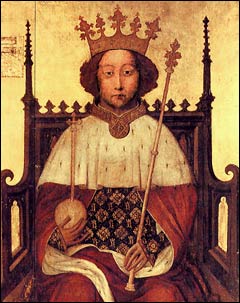

RICHARD II, King of England, younger son of Edward the Black Prince by Joan "the Fair Maid of Kent," was born at Bordeaux on the 6th of January 1367.
He was brought to England in 1371, and after his father's death was, on the petition of the Commons in parliament, created Prince of Wales on the 10th of November 1376.
When Edward III died, on the 21st of June 1377, Richard became king. Popular opinion had credited John of Gaunt with designs on the throne.
This was not justified; nevertheless, the rivalry of the boyking's uncles added another to the troubles due to the war, the Black Death and the prospect of a long minority.
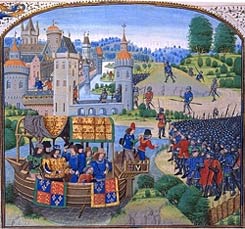 At first the
government was conducted by a council appointed by parliament. The council was honest, but the difficulties of the situation were too great. The ill-considered poll-tax of 1381 was the occasion,
though not the real cause, of the Peasants' Revolt in that year. The ministers were quite unequal to the crisis, and when Wat Tyler
and his followers got possession of London, it was Richard who showed a precocious tact and confidence in handling it. It was the boyking who met and temporized with the rebels on the 13th of June
at Mile End, and again next day at Smithfield; and he who, with courageous presence of mind, saved the situation when Tyler was killed, by calling on them to take him for their leader. At first the
government was conducted by a council appointed by parliament. The council was honest, but the difficulties of the situation were too great. The ill-considered poll-tax of 1381 was the occasion,
though not the real cause, of the Peasants' Revolt in that year. The ministers were quite unequal to the crisis, and when Wat Tyler
and his followers got possession of London, it was Richard who showed a precocious tact and confidence in handling it. It was the boyking who met and temporized with the rebels on the 13th of June
at Mile End, and again next day at Smithfield; and he who, with courageous presence of mind, saved the situation when Tyler was killed, by calling on them to take him for their leader.
From this time Richard began to assert himself. His chief ministers, appointed by parliament in 1382, were
the Earl of Arundel and Michael de la Pole. Arundel Richard disliked, and dismissed next year, when he began his personal government.
Pole, whom he retained as Chancellor and made Earl of Suffolk, was a well-chosen adviser. But others, and especially his youthful favourite Robert de Vere, promoted
by unheard-of honour to be Marquess of Dublin and Duke of Ireland, were less worthy. Further, Richard made his own position difficult by lavish extravagance and unseemly outbursts of temper.
He chafed under the restraint of his relatives, and therefore encouraged John of Gaunt in his Spanish enterprise. This gave the less
scrupulous Thomas of Gloucester his opportunity. Gloucester, supported by Arundel, attacked his nephew's ministers
in the parliament of 1386, and by open hints at deposition forced Richard to submit to a council of control.
When Richard, with the aid of his friends and by the advice of subservient judges, planned a reversal of the parliament, Gloucester, at the head of the so-called
Lords Appellant, anticipated him. Richard had been premature and ill-advised. Gloucester had the advantage of posing as the head of the constitutional party.
The king's friends were driven into exile or executed, and he himself forced to submit to the loss of all real power (May 1388). Richard changed his methods, and when the lords appellant had
lost credit, asserted himself constitutionally by dismissing Gloucester's supporters from office, and appointing in their place well-approved men like William of Wykeham. In the next parliament
of 1390 the king showed himself ready to meet and conciliate his subjects. The simultaneous return of John of Gaunt from Spain put a check on Gloucester's ambition. For seven
years Richard ruled constitutionally and on the whole well. The opposition was quiescent except for two outbreaks by Arundel: the first was a violent attack on John of Gaunt, which rather
strengthened Richard's position; the second was a wanton insult to the king at the funeral of his queen.
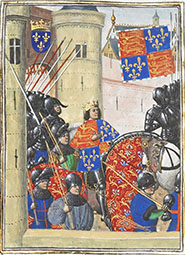 In January 1383 Richard had married Anne of Bohemia (1366-1394), daughter of the emperor Charles IV. The marriage, though childless, was happy; had Anne lived or borne a son the course of events
might have been different. Her death on the 7th of June 1394 was a great shock to Richard, and incidentally had important consequences. Richard sought distraction by an expedition to Ireland,
the first visit of an English king for more than two centuries. In his policy there he showed a wise statesmanship. At the same time he was negotiating for a permanent peace with France,
which was finally arranged in October 1396 to include his own marriage with Isabella, daughter of Charles VI, a child of seven. Gloucester criticized the peace openly, and there was some
show of opposition in the parliament of February 1397.
In January 1383 Richard had married Anne of Bohemia (1366-1394), daughter of the emperor Charles IV. The marriage, though childless, was happy; had Anne lived or borne a son the course of events
might have been different. Her death on the 7th of June 1394 was a great shock to Richard, and incidentally had important consequences. Richard sought distraction by an expedition to Ireland,
the first visit of an English king for more than two centuries. In his policy there he showed a wise statesmanship. At the same time he was negotiating for a permanent peace with France,
which was finally arranged in October 1396 to include his own marriage with Isabella, daughter of Charles VI, a child of seven. Gloucester criticized the peace openly, and there was some
show of opposition in the parliament of February 1397.
But there was nothing to foreshadow the sudden stroke by which, in July 1397, Richard arrested Gloucester and his chief supporters, the Earls of Arundel and Warwick. The others of the five
Lords Appellant, Henry of Bolingbroke afterwards King Henry IV, and the Earl of Nottingham, now supported the king. Richard's action
was apparently in deliberate revenge for the events of 1387-88. Gloucester, after a forced confession, died in prison at Calais, smothered by his nephew's orders. Arundel
in a packed parliament was condemned and executed; his brother Thomas Archbishop of Canterbury was exiled. The king's friends, including Nottingham and Bolingbroke,
made Dukes of Norfolk and Hereford, were all promoted in title and estate. Richard himself was rewarded for ten years' patience by the possession of absolute power. He might perhaps have
established it if he could have exercised it with moderation. But he declared that the laws of England were in his mouth, and supported his court in wanton luxury by arbitrary methods of
taxation.
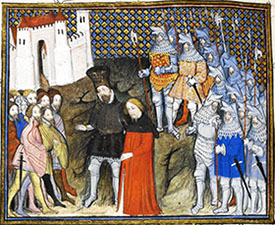
By
the exile of Norfolk and Hereford in September 1398 he seemed to have removed the last persons he need fear. He was so confident that
in May 1399 he paid a second visit to Ireland, taking with him all his most trusted adherents. Thus when Henry landed at Ravenspur in July he found only half-hearted opposition,
and when Richard himself returned it was too late. Ultimately Richard surrendered to Henry at Flint on the 19th of August, promising to abdicate if his life was spared.
He was taken to London riding behind his rival with indignity.
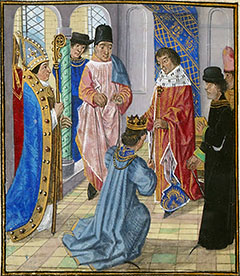 On the 30th of September
he signed in the Tower a deed of abdication, wherein he owned himself insufficient and useless, reading it first aloud with a cheerful mien and ending with a request that his cousin
would be good lord to him. The parliament ordered that Richard should be kept close prisoner, and he was sent secretly to Pontefract. There in February 1400 he died: no doubt of the rigour
of his winter imprisonment, rather than by actual murder as alleged in the story adopted by Shakespeare. The mystery of Richard's death led to rumours that he had escaped, and an
impostor pretending to be Richard lived during many years under the protection of the Scottish government. But no doubt it was the real Richard who was buried without state in 1400
at King's Langley, and honourably reinterred by Henry V at Westminster in 1413. On the 30th of September
he signed in the Tower a deed of abdication, wherein he owned himself insufficient and useless, reading it first aloud with a cheerful mien and ending with a request that his cousin
would be good lord to him. The parliament ordered that Richard should be kept close prisoner, and he was sent secretly to Pontefract. There in February 1400 he died: no doubt of the rigour
of his winter imprisonment, rather than by actual murder as alleged in the story adopted by Shakespeare. The mystery of Richard's death led to rumours that he had escaped, and an
impostor pretending to be Richard lived during many years under the protection of the Scottish government. But no doubt it was the real Richard who was buried without state in 1400
at King's Langley, and honourably reinterred by Henry V at Westminster in 1413.
Richard II is a character of strange contradictions. It is difficult to reconcile the precocious boy of 1381 with the wayward and passionate youth of the next few years.
Even if it be supposed that he dissembled his real opinions during the period of his constitutional rule, it is impossible to believe that the apparent indifference which
he showed in his fall was the mere acting of a part. His violent outbursts of passion perhaps give the best clue to a mercurial and impulsive nature, easily elated and depressed.
He had real ability, and in his Irish policy, and in the preference which he gave to it over continental adventure, showed a statesmanship in advance of his time. But this,
in spite of his lofty theory of kingship, makes it all the more difficult to explain his extravagant bearing in his prosperity.
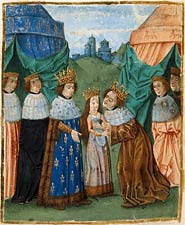 His fall was due to the triumph of national right over absolute government, but it was his personal conduct which made it inevitable. In appearance Richard was tall and handsome, if effeminate.
He had some literary tastes, which were shown in fitful patronage of Chaucer, Gower
and Froissart. His fancy for splendid dress may have been due to an artistic sense, which found better expression in his great buildings of Westminster Hall and Abbey.
Richard's second queen, Isabella (1389-1409), was born in Paris on the 9th of November 1389, and was married to the English king at Calais in October, or November, 1396,
but on account of the bride's youth the marriage was never consummated. When Richard lost his crown in 1399 Isabella was captured by Henry IV's partisans and sent to Sonning,
near Reading, while her father, Charles VI, asked in vain for the restoration of his daughter and of her dowry. In 1401 she was allowed to return to France; in 1406 she became
the wife of the poet, Charles, Duke of Orleans, and she died on the 13th of September 1409.
His fall was due to the triumph of national right over absolute government, but it was his personal conduct which made it inevitable. In appearance Richard was tall and handsome, if effeminate.
He had some literary tastes, which were shown in fitful patronage of Chaucer, Gower
and Froissart. His fancy for splendid dress may have been due to an artistic sense, which found better expression in his great buildings of Westminster Hall and Abbey.
Richard's second queen, Isabella (1389-1409), was born in Paris on the 9th of November 1389, and was married to the English king at Calais in October, or November, 1396,
but on account of the bride's youth the marriage was never consummated. When Richard lost his crown in 1399 Isabella was captured by Henry IV's partisans and sent to Sonning,
near Reading, while her father, Charles VI, asked in vain for the restoration of his daughter and of her dowry. In 1401 she was allowed to return to France; in 1406 she became
the wife of the poet, Charles, Duke of Orleans, and she died on the 13th of September 1409.
Excerpted from:
Encyclopedia Britannica, 11th Ed. Vol XXIII.
Cambridge: Cambridge University Press, 1910. 297.
Other Local Resources:
- Richard II painting at Westminster Palace
- Richard II after the painting at Westminster Palace
- Richard II creating Mowbray Earl Marshall, 1386
- Coronation of Richard II, historiated initial, 1390
- Philippe de Mézières presenting his epistle to Richard II, 1395
- Froissart presenting his Chronicles to Richard II, early 15th-c MS
- Illuminated Manuscript Portrait of Richard II, c1436
- Illuminated Manuscript Portrait of Richard II, c1445-1450
- Illuminated Manuscript Portrait of Richard II, 1451-1480
- Richard II Portrait at National Portrait Gallery, late 16th-c?
- Another Richard II Portrait at National Portrait Gallery, late 16th-c?
- Richard II Portrait in the Royal Collection, 16th-c?
- The Great Seal of King Richard II
- The Great Seal of Richard II, Nat. Archives
- The Coronation of Richard II, late 15th-c MS
- The Coronation of Richard II, c1470-80
- The Coronation of Richard II, c1470-80
- Richard II after his Coronation
- Richard II and the Kentish Rebels
- Richard II sets out for Ireland
- Richard II leaves for Ireland
- Richard II and the Irish Chiefs
- The Engagement of Richard II and Isabella of France
- The Betrothal of Richard II and Isabella of France
- Richard II Meeting Isabella of France
- The Meeting of Richard II and Isabella of France
- Richard II Receives Isabella of France
- Richard II arriving to see Gloucester at Pleshy Castle, Essex
- Froissart presenting his Chronicles to Richard II; BnF
- Froissart presenting his Chronicles to Richard II; BL
- Froissart presenting his Chronicles to Richard II; PML
- Richard II Granting Aquitaine to the Duke of Lancaster
- The Challenge of Derby and Mowbray
- Mowbray Challenges Derby
- Mowbray Throws the Gauntlet at Derby
- Mowbray, the Earl Marshal, Challenges Henry, Earl of Derby
- Richard II banishes Derby and Mowbray
- Richard II banishes Derby and Mowbray
- Richard II Rides to Flint Castle
- Richard I Receiving a Message Delivered by Henry Percy
- Meeting of Richard and Bolingbroke at Flint Castle
- Richard II Surrenders to the Earl of Derby
- The Arrest of Richard II
- Richard II being taken to the Tower of London
- Parliament assembled for the Deposition of Richard II
- Abdication of Richard II
- Richard II resigns his crown
- Crowning of Henry IV & Death of Richard II
- Coronation of Henry IV & Murder of Richard II
- The Funeral of Richard II; BnF
- The Funeral of Richard II; BL
- The Funeral of Richard II; BL 2
- Hundred Years' War
- King Edward III
- Edward, the Black Prince of Wales
- John of Gaunt, Duke of Lancaster
- Edmund of Langley, Duke of York
- King Henry IV, Bolingbroke
- House of Lancaster
- Wars of the Roses
Books for further study:
Bennett, Michael. Richard II, and the Revolution of 1399.
Sutton Publishing, 2006.
Bevan, Bryan. King Richard II.
Rubicon Press, 1996.
Biggs, Douglas. Three Armies in Britain: The Irish Campaign of Richard II
and the Usurpation of Henry IV, 1397-1399.
Brill Academic Publishers, 2006.
Saul, Nigel. Richard II.
Yale University Press, 1999.
Seward, Desmond. The Hundred Years War: The English in France 1337-1453.
Penguin, 1999.
Shakespeare, William. Richard II.
Folger Shakespeare Library, 2005.
Strohm, Paul. England's Empty Throne: Usurpation and
the Language of Legitimation, 1399-1422. (New Ed)
University of Notre Dame Press, 2006.
Richard II on the Web:
 | to Hundred Years' War
|
 | to Luminarium Encyclopedia |
Site ©1996-2022 Anniina Jokinen. All rights reserved.
This page was created on April 23, 2007. Last updated August 25, 2022.
|
Index of Encyclopedia Entries:
Medieval Cosmology
Prices of Items in Medieval England
Edward II
Isabella of France, Queen of England
Piers Gaveston
Thomas of Brotherton, E. of Norfolk
Edmund of Woodstock, E. of Kent
Thomas, Earl of Lancaster
Henry of Lancaster, Earl of Lancaster
Henry of Grosmont, Duke of Lancaster
Roger Mortimer, Earl of March
Hugh le Despenser the Younger
Bartholomew, Lord Burghersh, elder
Hundred Years' War (1337-1453)
Edward III
Philippa of Hainault, Queen of England
Edward, Black Prince of Wales
John of Eltham, Earl of Cornwall
The Battle of Crécy, 1346
The Siege of Calais, 1346-7
The Battle of Poitiers, 1356
Lionel of Antwerp, Duke of Clarence
John of Gaunt, Duke of Lancaster
Edmund of Langley, Duke of York
Thomas of Woodstock, Gloucester
Richard of York, E. of Cambridge
Richard Fitzalan, 3. Earl of Arundel
Roger Mortimer, 2nd Earl of March
The Good Parliament, 1376
Richard II
The Peasants' Revolt, 1381
Lords Appellant, 1388
Richard Fitzalan, 4. Earl of Arundel
Archbishop Thomas Arundel
Thomas de Beauchamp, E. Warwick
Robert de Vere, Earl of Oxford
Ralph Neville, E. of Westmorland
Thomas Mowbray, Duke of Norfolk
Edmund Mortimer, 3. Earl of March
Roger Mortimer, 4. Earl of March
John Holland, Duke of Exeter
Michael de la Pole, E. Suffolk
Hugh de Stafford, 2. E. Stafford
Henry IV
Edward, Duke of York
Edmund Mortimer, 5. Earl of March
Henry Percy, Earl of Northumberland
Sir Henry Percy, "Harry Hotspur"
Thomas Percy, Earl of Worcester
Owen Glendower
The Battle of Shrewsbury, 1403
Archbishop Richard Scrope
Thomas Mowbray, 3. E. Nottingham
John Mowbray, 2. Duke of Norfolk
Thomas Fitzalan, 5. Earl of Arundel
Henry V
Thomas, Duke of Clarence
John, Duke of Bedford
Humphrey, Duke of Gloucester
John Talbot, Earl of Shrewsbury
Richard, Earl of Cambridge
Henry, Baron Scrope of Masham
William de la Pole, Duke of Suffolk
Thomas Montacute, E. Salisbury
Richard Beauchamp, E. of Warwick
Henry Beauchamp, Duke of Warwick
Thomas Beaufort, Duke of Exeter
Cardinal Henry Beaufort
John Beaufort, Earl of Somerset
Sir John Fastolf
John Holland, 2. Duke of Exeter
Archbishop John Stafford
Archbishop John Kemp
Catherine of Valois
Owen Tudor
John Fitzalan, 7. Earl of Arundel
John, Lord Tiptoft
Charles VII, King of France
Joan of Arc
Louis XI, King of France
Charles the Bold, Duke of Burgundy
The Battle of Agincourt, 1415
The Battle of Castillon, 1453
The Wars of the Roses 1455-1485
Causes of the Wars of the Roses
The House of Lancaster
The House of York
The House of Beaufort
The House of Neville
The First Battle of St. Albans, 1455
The Battle of Blore Heath, 1459
The Rout of Ludford, 1459
The Battle of Northampton, 1460
The Battle of Wakefield, 1460
The Battle of Mortimer's Cross, 1461
The 2nd Battle of St. Albans, 1461
The Battle of Towton, 1461
The Battle of Hedgeley Moor, 1464
The Battle of Hexham, 1464
The Battle of Edgecote, 1469
The Battle of Losecoat Field, 1470
The Battle of Barnet, 1471
The Battle of Tewkesbury, 1471
The Treaty of Pecquigny, 1475
The Battle of Bosworth Field, 1485
The Battle of Stoke Field, 1487
Henry VI
Margaret of Anjou
Richard Plantagenet, Duke of York
Edward IV
Elizabeth Woodville
Richard Woodville, 1. Earl Rivers
Anthony Woodville, 2. Earl Rivers
Jane Shore
Edward V
Richard III
George, Duke of Clarence
Ralph Neville, 2. Earl of Westmorland
Richard Neville, Earl of Salisbury
Richard Neville, Earl of Warwick
Edward Neville, Baron Bergavenny
William Neville, Lord Fauconberg
Robert Neville, Bishop of Salisbury
John Neville, Marquis of Montagu
George Neville, Archbishop of York
John Beaufort, 1. Duke Somerset
Edmund Beaufort, 2. Duke Somerset
Henry Beaufort, 3. Duke of Somerset
Edmund Beaufort, 4. Duke Somerset
Margaret Beaufort
Edmund Tudor, Earl of Richmond
Jasper Tudor, Earl of Pembroke
Humphrey Stafford, D. Buckingham
Henry Stafford, Duke of Buckingham
Humphrey Stafford, E. of Devon
Thomas, Lord Stanley, Earl of Derby
Sir William Stanley
Archbishop Thomas Bourchier
Henry Bourchier, Earl of Essex
John Mowbray, 3. Duke of Norfolk
John Mowbray, 4. Duke of Norfolk
John Howard, Duke of Norfolk
Henry Percy, 2. E. Northumberland
Henry Percy, 3. E. Northumberland
Henry Percy, 4. E. Northumberland
William, Lord Hastings
Henry Holland, Duke of Exeter
William Fitzalan, Earl of Arundel
William Herbert, 1. Earl of Pembroke
John de Vere, 12th Earl of Oxford
John de Vere, 13th Earl of Oxford
Thomas de Clifford, 8. Baron Clifford
John de Clifford, 9. Baron Clifford
John Tiptoft, Earl of Worcester
Thomas Grey, 1. Marquis Dorset
Sir Andrew Trollop
Archbishop John Morton
Edward Plantagenet, E. of Warwick
John Talbot, 2. E. Shrewsbury
John Talbot, 3. E. Shrewsbury
John de la Pole, 2. Duke of Suffolk
John de la Pole, E. of Lincoln
Edmund de la Pole, E. of Suffolk
Richard de la Pole
John Sutton, Baron Dudley
James Butler, 5. Earl of Ormonde
Sir James Tyrell
Edmund Grey, first Earl of Kent
George Grey, 2nd Earl of Kent
John, 5th Baron Scrope of Bolton
James Touchet, 7th Baron Audley
Walter Blount, Lord Mountjoy
Robert Hungerford, Lord Moleyns
Thomas, Lord Scales
John, Lord Lovel and Holand
Francis Lovell, Viscount Lovell
Sir Richard Ratcliffe
William Catesby
Ralph, 4th Lord Cromwell
Jack Cade's Rebellion, 1450
Tudor Period
King Henry VII
Queen Elizabeth of York
Arthur, Prince of Wales
Lambert Simnel
Perkin Warbeck
The Battle of Blackheath, 1497
King Ferdinand II of Aragon
Queen Isabella of Castile
Maximilian I, Holy Roman Emperor
King Henry VIII
Queen Catherine of Aragon
Queen Anne Boleyn
Queen Jane Seymour
Queen Anne of Cleves
Queen Catherine Howard
Queen Katherine Parr
King Edward VI
Queen Mary I
Queen Elizabeth I
Henry Fitzroy, Duke of Richmond
Margaret Tudor, Queen of Scotland
James IV, King of Scotland
The Battle of Flodden Field, 1513
James V, King of Scotland
Mary of Guise, Queen of Scotland
Mary Tudor, Queen of France
Louis XII, King of France
Francis I, King of France
The Battle of the Spurs, 1513
Field of the Cloth of Gold, 1520
Charles V, Holy Roman Emperor
Eustace Chapuys, Imperial Ambassador
The Siege of Boulogne, 1544
Cardinal Thomas Wolsey
Archbishop Thomas Cranmer
Thomas Cromwell, Earl of Essex
Thomas, Lord Audley
Thomas Wriothesley, E. Southampton
Sir Richard Rich
Edward Stafford, D. of Buckingham
Thomas Howard, 2nd Duke of Norfolk
Thomas Howard, 3rd Duke of Norfolk
John Dudley, Duke of Northumberland
Charles Brandon, Duke of Suffolk
Thomas Boleyn, Earl of Wiltshire
George Boleyn, Viscount Rochford
John Russell, Earl of Bedford
Thomas Grey, 2. Marquis of Dorset
Henry Grey, D. of Suffolk
Charles Somerset, Earl of Worcester
George Talbot, 4. E. Shrewsbury
Francis Talbot, 5. E. Shrewsbury
Henry Algernon Percy,
5th Earl of Northumberland
Henry Algernon Percy,
6th Earl of Northumberland
Ralph Neville, 4. E. Westmorland
Henry Neville, 5. E. Westmorland
William Paulet, Marquis of Winchester
Sir Francis Bryan
Sir Nicholas Carew
John de Vere, 15th Earl of Oxford
John de Vere, 16th Earl of Oxford
Thomas Seymour, Lord Admiral
Edward Seymour, Protector Somerset
Margaret Pole, Countess of Salisbury
Henry Pole, Lord Montague
Sir Geoffrey Pole
Thomas Manners, Earl of Rutland
Henry Manners, Earl of Rutland
Henry Bourchier, 2. Earl of Essex
Robert Radcliffe, 1. Earl of Sussex
Henry Radcliffe, 2. Earl of Sussex
George Hastings, Earl of Huntingdon
Henry Courtenay, Marquis of Exeter
George Neville, Baron Bergavenny
Sir Edward Neville
William, Lord Paget
William Sandys, Baron Sandys
William Fitzwilliam, E. Southampton
Sir Anthony Browne
Sir Thomas Wriothesley
Sir William Kingston
George Brooke, Lord Cobham
Sir Richard Southwell
Thomas Fiennes, 9th Lord Dacre
Sir Francis Weston
Henry Norris
Lady Jane Grey
Sir Thomas Arundel
Sir Richard Sackville
Sir William Petre
Sir John Cheke
Walter Haddon, L.L.D
Sir Peter Carew
Sir John Mason
Nicholas Wotton
John Taylor
Sir Thomas Wyatt, the Younger
Cardinal Lorenzo Campeggio
Cardinal Reginald Pole
Stephen Gardiner, Bishop of Winchester
Edmund Bonner, Bishop of London
Nicholas Ridley, Bishop of London
John Hooper, Bishop of Gloucester
John Aylmer, Bishop of London
Thomas Linacre
William Grocyn
Archbishop William Warham
Cuthbert Tunstall, Bishop of Durham
Richard Fox, Bishop of Winchester
Edward Fox, Bishop of Hereford
Pope Julius II
Pope Leo X
Pope Clement VII
Pope Paul III
Pope Pius V
Pico della Mirandola
Desiderius Erasmus
Martin Bucer
Richard Pace
Christopher Saint-German
Thomas Tallis
Elizabeth Barton, the Nun of Kent
Hans Holbein, the Younger
The Sweating Sickness
Dissolution of the Monasteries
Pilgrimage of Grace, 1536
Robert Aske
Anne Askew
Lord Thomas Darcy
Sir Robert Constable
Oath of Supremacy
The Act of Supremacy, 1534
The First Act of Succession, 1534
The Third Act of Succession, 1544
The Ten Articles, 1536
The Six Articles, 1539
The Second Statute of Repeal, 1555
The Act of Supremacy, 1559
Articles Touching Preachers, 1583
Queen Elizabeth I
William Cecil, Lord Burghley
Robert Cecil, 1st Earl of Salisbury
Sir Francis Walsingham
Sir Nicholas Bacon
Sir Thomas Bromley
Robert Dudley, Earl of Leicester
Ambrose Dudley, Earl of Warwick
Henry Carey, Lord Hunsdon
Sir Thomas Egerton, Viscount Brackley
Sir Francis Knollys
Katherine "Kat" Ashley
Lettice Knollys, Countess of Leicester
George Talbot, 6. E. of Shrewsbury
Elizabeth, Countess of Shrewsbury
Gilbert Talbot, 7. E. of Shrewsbury
Sir Henry Sidney
Sir Robert Sidney
Archbishop Matthew Parker
Walter Devereux, 1st Earl of Essex
Robert Devereux, 2nd Earl of Essex
Penelope Devereux, Lady Rich
Sir Christopher Hatton
Edward Courtenay, E. Devonshire
Edward Manners, 3rd Earl of Rutland
Thomas Radcliffe, 3. Earl of Sussex
Henry Radcliffe, 4. Earl of Sussex
Robert Radcliffe, 5. Earl of Sussex
William Parr, Marquis of Northampton
Henry Wriothesley, 2. Southampton
Henry Wriothesley, 3. Southampton
Charles Neville, 6. E. Westmorland
Thomas Percy, 7. E. Northumberland
Henry Percy, 8. E. Northumberland
Henry Percy, 9. E. Nothumberland
William Herbert, 1. Earl of Pembroke
Charles, Lord Howard of Effingham
Thomas Howard, 4th Duke of Norfolk
Henry Howard, 1. Earl of Northampton
Thomas Howard, 1. Earl of Suffolk
Henry Hastings, 3. E. of Huntingdon
Edward Manners, 3rd Earl of Rutland
Roger Manners, 5th Earl of Rutland
Francis Manners, 6th Earl of Rutland
Henry FitzAlan, 12. Earl of Arundel
Thomas, Earl Arundell of Wardour
Edward Somerset, E. of Worcester
William Davison
Sir Walter Mildmay
Sir Ralph Sadler
Sir Amyas Paulet
Gilbert Gifford
Anthony Browne, Viscount Montague
François, Duke of Alençon & Anjou
Mary, Queen of Scots
Henry Stuart, Lord Darnley
James Hepburn, Earl of Bothwell
Anthony Babington and the Babington Plot
John Knox
Philip II of Spain
The Spanish Armada, 1588
Sir Francis Drake
Sir John Hawkins
William Camden
Archbishop Whitgift
Martin Marprelate Controversy
John Penry (Martin Marprelate)
Richard Bancroft, Archbishop of Canterbury
John Dee, Alchemist
Philip Henslowe
Edward Alleyn
The Blackfriars Theatre
The Fortune Theatre
The Rose Theatre
The Swan Theatre
Children's Companies
The Admiral's Men
The Lord Chamberlain's Men
Citizen Comedy
The Isle of Dogs, 1597
Common Law
Court of Common Pleas
Court of King's Bench
Court of Star Chamber
Council of the North
Fleet Prison
Assize
Attainder
First Fruits & Tenths
Livery and Maintenance
Oyer and terminer
Praemunire
The Stuarts
King James I of England
Anne of Denmark
Henry, Prince of Wales
The Gunpowder Plot, 1605
George Villiers, 1st Duke of Buckingham
Robert Carr, Earl of Somerset
Arabella Stuart, Lady Lennox
William Alabaster
Bishop Hall
Bishop Thomas Morton
Archbishop William Laud
John Selden
Lucy Harington, Countess of Bedford
Henry Lawes
King Charles I
Queen Henrietta Maria
Long Parliament
Rump Parliament
Kentish Petition, 1642
Thomas Wentworth, Earl of Strafford
John Digby, Earl of Bristol
George Digby, 2nd Earl of Bristol
Thomas Fairfax, 3rd Lord Fairfax
Robert Devereux, 3rd E. of Essex
Robert Sidney, 2. E. of Leicester
Algernon Percy, E. of Northumberland
Henry Montagu, Earl of Manchester
Edward Montagu, 2. Earl of Manchester
The Restoration
King Charles II
King James II
Test Acts
Greenwich Palace
Hatfield House
Richmond Palace
Windsor Palace
Woodstock Manor
The Cinque Ports
Mermaid Tavern
Malmsey Wine
Great Fire of London, 1666
Merchant Taylors' School
Westminster School
The Sanctuary at Westminster
"Sanctuary"
Images:
Chart of the English Succession from William I through Henry VII
Medieval English Drama
London c1480, MS Royal 16
London, 1510, the earliest view in print
Map of England from Saxton's Descriptio Angliae, 1579
London in late 16th century
Location Map of Elizabethan London
Plan of the Bankside, Southwark, in Shakespeare's time
Detail of Norden's Map of the Bankside, 1593
Bull and Bear Baiting Rings from the Agas Map (1569-1590, pub. 1631)
Sketch of the Swan Theatre, c. 1596
Westminster in the Seventeenth Century, by Hollar
Visscher's View of London, 1616
Larger Visscher's View in Sections
c. 1690. View of London Churches, after the Great Fire
The Yard of the Tabard Inn from Thornbury, Old and New London
|
|